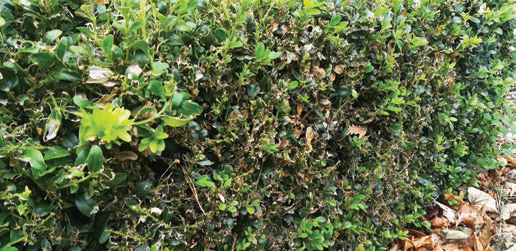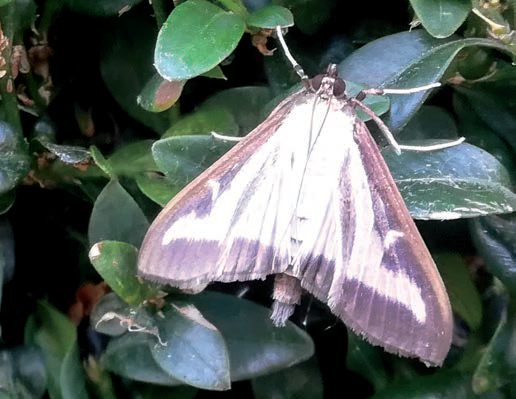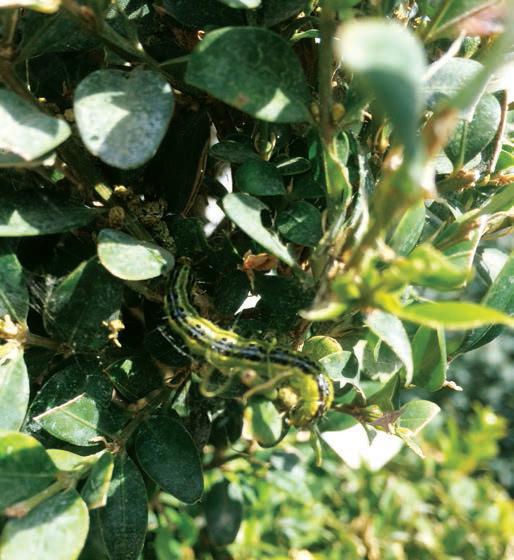Teagasc Nursery Stock Advisor, Dónall Flanagan suggests vigilance and caution as the first incidence of box moth is identified in Ireland
Box (Buxus sempervirens) has suffered some bad press of late; already suffering from blight, now with the first reports of box moth caterpillar coming in, cultivation will need to be reviewed. In time the box may well be treated like roses, requiring pest and disease control.
Box contradicts the term ‘common’. It’s everywhere but is still a desirable plant. It’s a high-status plant for landscaping and topiary. Estimates of imports of close to a million plants a year show it’s an important and economically valuable plant. The vast majority of box produced in Europe is grown by specialists in Belgium and the Netherlands and they are very skilled at it. However, the last few years have not been so kind to them. Demand on the Continent has declined significantly, and by 75% on some nurseries. Pest and disease have tarnished its good name. Didier Hermans, owner of Herplant (one of the biggest producers of the box in Europe) says, “The markets in Belgium and Holland have crashed because of the caterpillar and the very negative news in newspapers and on TV stations”. There are widespread reports from the UK and the Continent of the dramatic damage caused – defoliation of plants over a weekend. It resulted in large amounts of the plant being replaced with alternative species.
BOX BLIGHT
Two relatively new box diseases have caused much damage to the plants since first reported over 15 years ago. Blackening or browning and death of foliage are caused by the fungal pathogens Calonectria pseudonaviculata (syn.Cylindrocladium buxicola) and Volutella buxi (syn. Pseudonectria buxi). Both thrive on Buxus plants in warm, humid conditions. Warm, wet summers and transport conditions give the disease a chance to take hold. Box blight can be spread by wind and by contact, e.g. pruning and on footwear. Growers have been well able to manage the disease by addressing spacing and using good hygiene. Disease control using preventative treatments has been successful but is another new job on the nursery. US research in 2015 by LaMondia et al showed systemic and protectant fungicide applications “had significant efficacy” and were almost 100% successful. In Ireland, there are good plant protections options available that have been proven to be effective over the last few years. In public planting, pruning once during the summer is now the norm, twice used to be recommended, and collecting clippings has helped to reduce the opportunities for the disease to take hold. Some foliar feeds are also well regarded. As you can imagine, the recent summer weather was good for the plants and not the disease.
Herplants have been working on resistance breeding programmes for over 10 years. Thousands of new hybrids have been assessed and this October at GrootGroenPlus, a major Dutch trade fair, they presented four new resistant cultivars. These plants are expected on the market by late 2019. In the meantime, there are some very good varieties that Teagasc has been growing: ‘Faulkner’, ‘John Baldwin’, ‘Rococo’ and ‘Justin Brouwers’ have shown to be very good in ordinary growing conditions. Next the plants will be inoculated with different concentrations of blight spores to assess their levels of resistance. Didier Herman says, “There are good biosolutions to treat but a lot of garden owners in Belgium and Holland do nothing. We have a lot of information on our website www.buxuscare.com”.
BOX MOTH
This September saw the first recorded incidence of box moth (Cydalima persimilis) in Ireland. Mature established hedgerows in Blackrock and Rathfarnham in Dublin had signs of feeding damage from caterpillars and defoliation. Caterpillars and chrysalis from one site confirmed it was box moth caterpillar. As these were established hedges, not recent imports, they must have become colonised by laying adult moths. It can be assumed the pest is established at least in some pockets. The pest first arrived in Europe from Asia in 2007. Since then it has spread to most of Europe. Severe damage is often seen with plants being stripped of foliage in just a few weeks. It has caused devastation in some areas where native Buxus forests grow, and many have been destroyed. The caterpillars overwinter in cocoons tightly wrapped between leaves, they begin to feed in spring and by mid-April they are on the wing as adults. The adult females seek new box plants to lay their eggs on. In warm weather, the developing caterpillars grow quickly to produce another generation. The caterpillars feed only on the leaves of box plants. If they run out of leaves they can feed on the stems causing the death of the plant. Only dormant protected caterpillars can survive winter, adult moths cannot. Their natural spread is about 7km a year. However, unintentional trade of infested plants will be the quickest route to spread them. Climate and natural population migration models suggest the pest will establish in Ireland in substantial population densities. It looks likely there will be two generations per year in parts of the country but there is much to learn about the moth’s survival in Ireland. Dr. Melanie Tuffen, biosecurity coordinator for the RHS in UK and previously worked with Teagasc and DAFM says, “In Ireland, where summers are generally cooler than the Continent, the box tree moth is unlikely to have as many generations per year than is seen in Central and Southern to have as many generations seen per year than in Central and Southern France where it is highly damaging. This may help reduce the impacts of this pest compared to those seen in Europe”.
The Belgian horticulture research agency PCS and its partners have a very thorough website www.sosbuxusmot.be Their research carried out over four years identified the most effective professional IPM and plant protection products, many of which are available in Ireland and are very selective at controlling caterpillars only. RHS trials of home use products found that the nematode control was more effective than the chemical control options.
Growers and landscapers should take action in 2019. Effective IPM options should be used, monitoring plants regularly for caterpillars from April onwards and using pheromone traps to detect male moths. If adult caterpillars are found, follow up with the biological treatment Bacillus thuringiensis.
ALTERNATIVES
It’s likely that box will always have a place in Ireland. Our relatively mild climate allows us to grow a good range of alternatives. Ronald Hautman, a Dutch plant consultant, said that there is no one plant that fills all the roles of box. There are many online recommendations, the most likely candidates to consider are: Euonymus fortunei (various cultivars), Ilex crenata, Lonicera nitida var. ‘Moss Green’ and ‘May Green’, Pittosporum tenuifolium var. ‘Golf Ball’, Sarcococca sp. Taxus baccata and Ugni molinae.
The coming year will tell a lot about how our plants will cope with the new challenges. For now, I urge caution and to give these valuable plants a little more attention than we have in the past. If you need advice on protection programmes, please visit the Teagasc website or contact me directly. ✽


  Dónall Flanagan, Ashtown Food Research Centre Mobile: 087 703 5823; Tel: 076 111 4021 Email: donall.flanagan@teagasc.ie |









